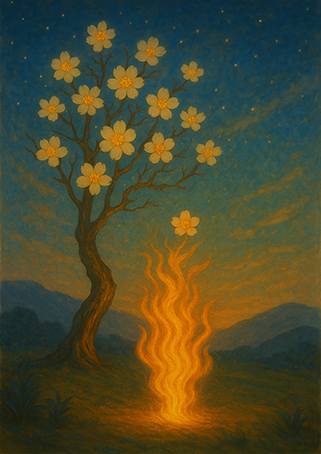Xieyi・The Rootless Tree:24 Chapters-Chapter 9#329

The poems of “The Rootless Tree” express a fundamental force rooted in harmony with heaven and earth, the cyclical flow of yin and yang, and the infinite potential of existence。
This painting is an expressive “Xieyi” in the tradition of “futu” (spiritual diagrams), passed down for generations in Wudang Mountain, China. It is drawn through a technique where energy flow (xingqi) channels the internal intention into visual form。 In the Taoist world, there exist spiritual and symbolic images called “futu”。
In the Taoist world, there exist spiritual and symbolic images called “futu”。
These are a type of talisman—not merely religious items, but expressive spiritual paintings that act directly on the mind of the viewer。
Since ancient times, many people have placed these Taoist-style “Xieyi” and futu in their homes, studies, or bedrooms, wishing for longevity, health, auspiciousness, and family harmony. Viewing such paintings was not just aesthetic appreciation, but an act of inviting the presence of the Dao into one’s life and tuning the body and mind。
Thus, “Xieyi” is more than artistic expression—it is a medium that bridges the spirit, life, and harmony with the universe。
This kind of artwork is not meant to be seen only with the eyes, but felt with the heart。
It communicates with the Dao, resonates with the qi of nature, and quietly stirs the viewer’s inner self。
Futu and “Xieyi” continue to live on from ancient times to this day as “sacred images that speak to the soul.”
Below, we present the original text of the philosophical poem “The Rootless Tree,” along with a modern Japanese translation and interpretation。
※ The author of “The Rootless Tree,” Zhang Sanfeng (1247–?), is also renowned as the founder of Tai Chi, and it is said that he applied the essence of this work to Tai Chi. As an additional note, we include an interpretation connecting this to the Tai Chi tradition of Wudang Mountain.
Details of Tao Code, Feng Shui and talismans in Xieyi Painting
The composition draws a wide arc — ink flows outward then loops gently back, while subtle gold threads trace the trajectory of return. The space opens and closes simultaneously, inviting the viewer into the rhythm of departure and reunion, of dissolution and emergence.
This painting embodies the cycle of Returning Qi (Huan Qi) — the energy of restoration, integration, and wholeness. It is ideal for spaces that seek grounding and renewal, such as entrance halls, private retreats, or contemplative corners. The golden highlights resonate with the Metal element, refining clarity and precision, while the flowing ink clears stagnation and beckons continuous movement.
May this painting serve as a silent talisman — a visual conduit of Qi that brings return into being, reminding us that separation and reunion are but two aspects of the same movement.
The Rootless Tree・Chapter 9

▶Original Text
無根樹,花正開,偃月爐中摘下來。延年夀,減病災,好結良朋備法財。從兹可成天上寶,一任羣迷笑我獃。勸賢才,休賣乖,不遇明師莫强猜。
▶Modern Translation
Now the blossom on the rootless tree has opened.
It is plucked in the “Crescent Moon Furnace.”
Its power extends life and reduces illness.
Prepare by forming bonds of Dharma and resources with good friends.
Thus, you will gain Heaven’s treasure.
Let them laugh—wise ones do not scheme.
Do not interpret the Way on your own without meeting a true teacher.
▶Interpretation
• “Crescent Moon Furnace” = the body, especially the dantian.
• “Dharma resources” = companions, tools, teachings.
• True learning requires guidance—not self-constructed shortcuts.
▶Interpretation related to Tai Chi
• Results are gathered at the dantian—store and issue qi.
• The master’s role is indispensable.
• Do not be swayed by worldly opinions—stay on the path.
Copyright © MASAKI WAKABAYASHI. All rights reserved.




